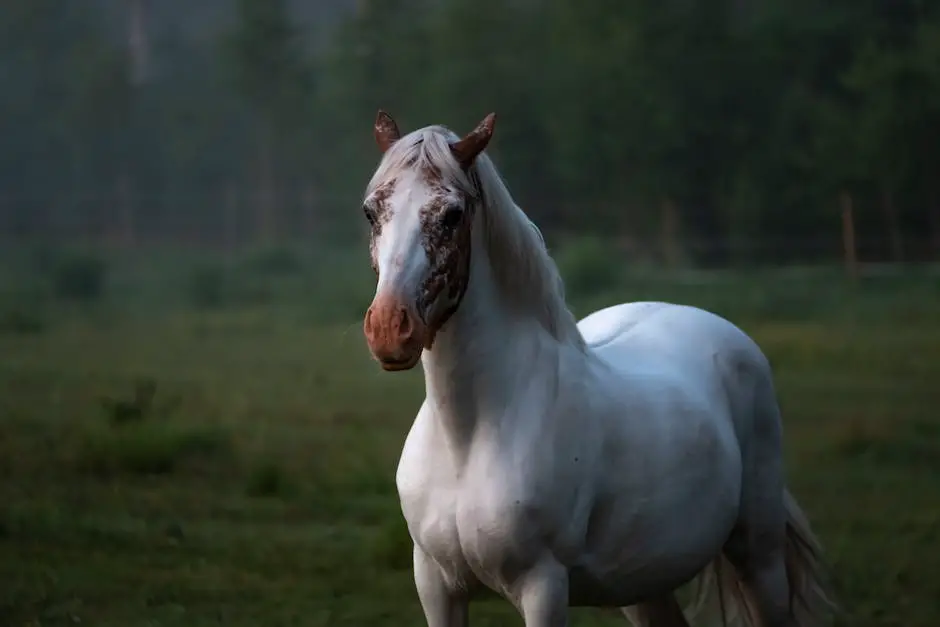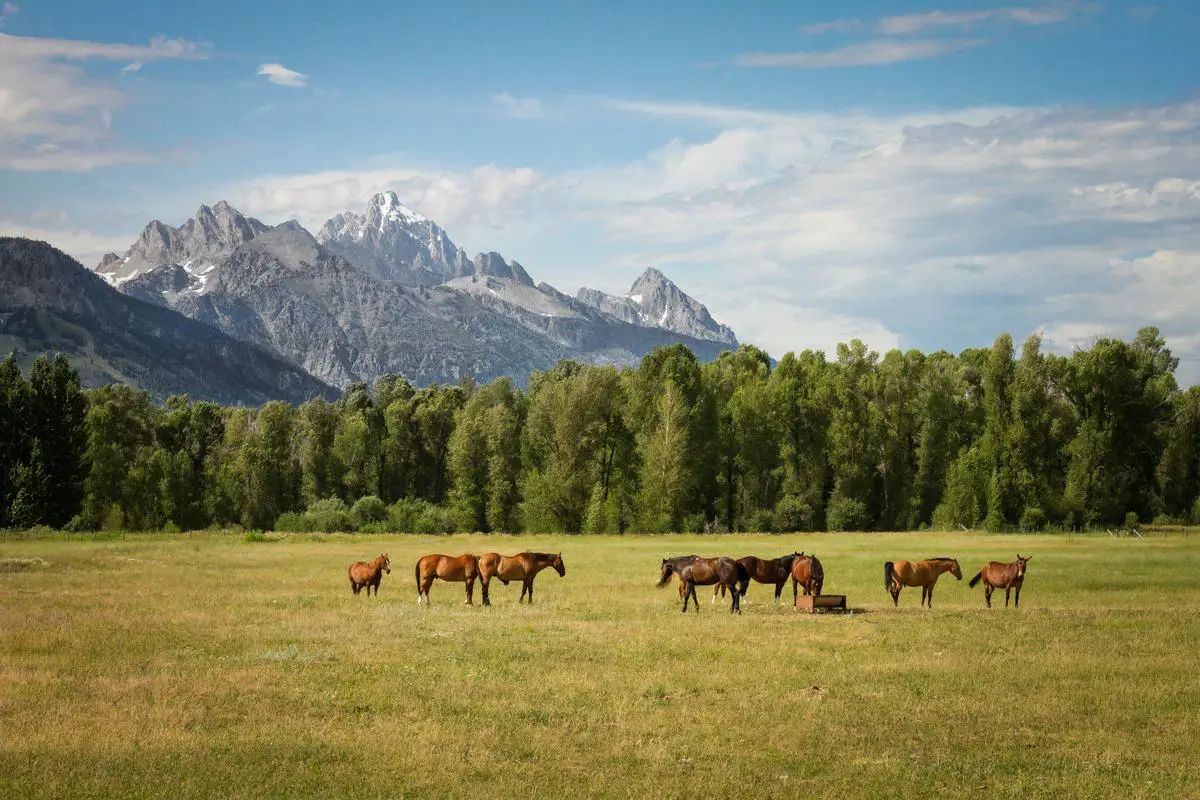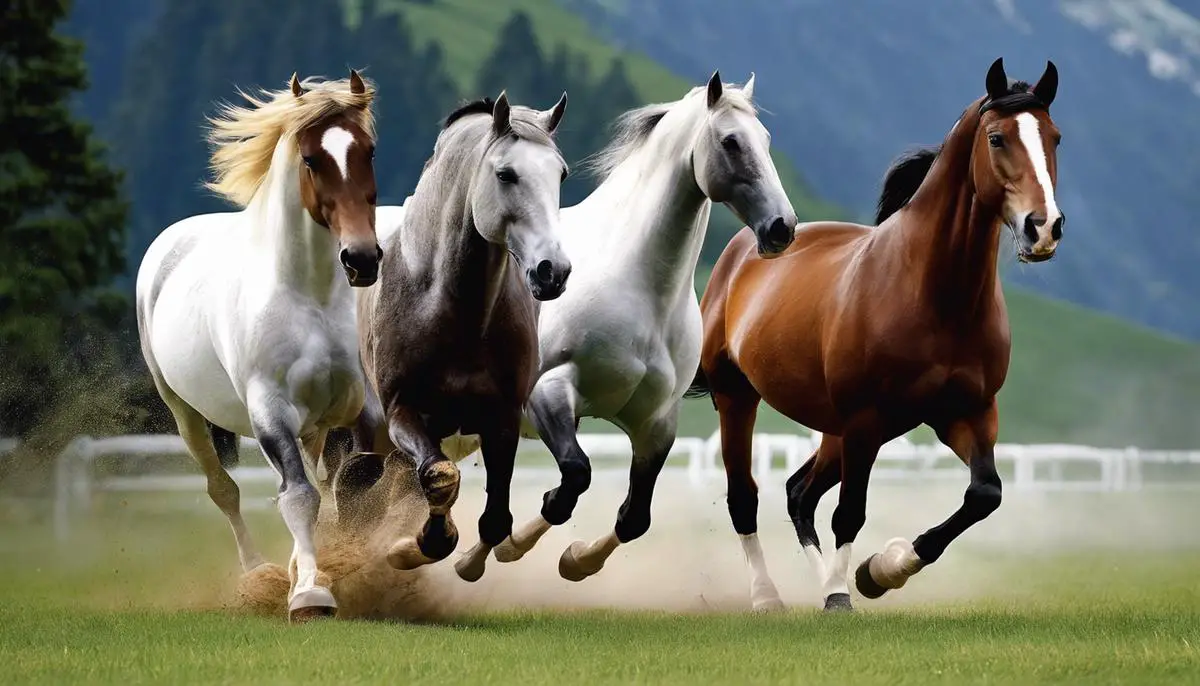Nestled within the picturesque landscapes of Switzerland lies a rich heritage of equine excellence, deeply rooted in the culture and traditions of this alpine nation. The story of Swiss horse breeding is one of meticulous care and profound respect for the majestic creatures that have served both as working partners and symbols of national pride throughout the centuries. The evolution of this practice is a captivating tale, mirroring the country’s topography and the needs of its people, from the resilient draft animals of yesteryear to the versatile sport horses that grace today’s competitions. Through exploring the diverse tapestries of the past, and dissecting the phenotypic and genotypic splendors of breeds like the Freiberger and Haflinger, we gain a holistic understanding of the Swiss equine narrative, one that continues to gallop forward with innovation and a steadfast commitment to genetic preservation.
Table of Contents (Horspedia)
History and Development of Swiss Horse Breeding
Temporal Progression of Equine Husbandry in Switzerland: A Historical Overview
Abstract:
Swiss horse breeding, a time-honored practice characterized by meticulous selection and enhancement, has undergone considerable evolution over centuries. This article delineates the chronological advancements in equine husbandry within Switzerland, emphasizing the interplay between sociocultural demand and genetic selection that has culminated in the horses we recognize today.
Introduction:
The domestication of the horse, Equus ferus caballus, and its subsequent breeding practices have played a pivotal role in shaping human civilization. In Switzerland, the evolution of horse breeding is not only an agricultural achievement but also a cultural heritage that reflects a profound understanding of genetics, environment, and purpose-driven selection.
Historical Context and Early Practices:
In medieval Switzerland, horses were predominantly used for transportation, agriculture, and military purposes. The early Swiss horse breeders, with their pragmatism, sought robust animals capable of traversing the diverse topography of the region. Breeding strategies then were largely empirical, with a focus on strength and endurance rather than aesthetics or speed.
The Influence of Warfare and Agriculture:
As warfare evolved, so did the need for horses with specific attributes. The Swiss cavalry called for agile and sturdy mounts able to bear the weight of armored knights. This demand instigated selective breeding methods to produce the now-extinct heavy warhorses. Concurrently, agricultural advancements necessitated draft horses, leading to the development of breeds like the Swiss Freiberger, known for their versatility and resilience.
The Renaissance of Swiss Horse Breeding:
The Renaissance brought an amplified artistic and scholarly appreciation for the equine form. Breeding initiatives became more sophisticated, incorporating principles of heredity. The desired traits evolved beyond mere brawn to include aesthetics, giving rise to new lineages boasting finer conformation and gait.
The Advent of Modern Equine Genetics:
With the onset of the modern era, scientific breakthroughs in genetics and animal husbandry propelled Swiss horse breeding into a new epoch. The rise of equestrian sports, as well as leisure riding, demanded horses with speed, agility, and a compliant temperament, leading to a diversification of breeding goals.
Contemporary Framework and Breed Conservation:
Continuing into the contemporary period, Switzerland has established itself as a purveyor of premium sport horses, particularly for dressage and jumping. However, the shifting landscape of rural economies and mechanization has led to the decline of traditional draft horse breeds. Consequently, there is now an increased emphasis on the conservation of native breeds, recognizing their cultural significance and genetic uniqueness.
Conclusion:
The Swiss approach to horse breeding is one marked by a confluence of historical utility, aesthetic preference, and scientific advancement. From medieval battles to modern competition arenas, the Swiss equine industry has adeptly navigated the ebb and flow of societal needs, shaping majestic creatures well-suited to the changing contours of human ambition. The current focus on preservation and sustainable breeding ensures that the legacy of Swiss equine excellence will endure, galloping through history toward a future that honors an illustrious past.

Major Swiss Horse Breeds and Their Characteristics
Phenotypical and Behavioral Characteristics of Prominent Swiss Equine Breeds
Within the realm of equine studies, a keen examination of Swiss horse breeds reveals a fascinating array of traits that distinguish these creatures as both historically significant and relevant in modern contexts. Swiss equine breeds reflect an amalgamation of selective breeding practices cultivated over centuries and display characteristics that are acutely suited to the variable topographies and climatic conditions inherent to Switzerland.
Among the most notable Swiss horse breeds is the Freiberger, often referred to as the Franches-Montagnes, hailing from the Jura region. This breed is marked by its versatility and robust constitutions, characteristics underpinning its historical role in the Swiss military. Freibergers also exhibit a balanced temperament, making them ideal for both riding and draft work. They typically exhibit a medium build, with strong limbs and a broad chest, representing well the dual-purpose nature their breeding dictates.
Another breed of significant heritage is the Haflinger, also known as the Avelignese. Recognizable by its chestnut coat and flaxen mane and tail, the Haflinger traces its genetic lineage to both Austrian and Swiss ancestries with remarkable consistency. These equids stand out for their gentle demeanor and are well-suited to a wide array of equestrian activities, from therapeutic riding to competitive sports. What is particularly interesting is the Haflinger’s endurance and agility, developed through selective breeding to navigate precipitous alpine terrain.
The Swiss Warmblood, or Einsiedler, is a breed less ancient but superbly honed for sport and competition, reflecting an emphasis on performance and conformation in their breeding requirements. The athleticism of the Swiss Warmblood is underscored by their muscular frame, spirited nature, and pronounced withers, contributing to their adeptness in show jumping and dressage. Their refined gaits and elastic movements compliment their physical capabilities and have positioned them as contenders on an international scale.
Embedded in the characteristics of these breeds are not only the biological criteria imposed by rigorous breeding regimes but also the cultural and economic narratives that have historically shaped the Swiss equine landscape. Traits such as resilience, adaptability, and temperamental stability reflect the requirements of the environments these breeds have been crafted to master.
It is imperative to maintain a scientific perspective when analyzing the traits inherent to these Swiss horse breeds. The morphological and behavioral qualities serve as phenotypic markers that elucidate the genetic stratifications and selective breeding choices discerned over time. The result is an assemblage of equine breeds that not only embody Swiss historical development, but also perpetuate the values and requirements of a nation intrinsically linked to its equestrian companions.
In advancing the understanding of these unique breeds, continued research and empirical studies are paramount to appreciate their contextual utility and to ensure their persistence in an era where traditional uses of horses are diminishing, but their cultural and historic significance, as well as their contribution to biodiversity, remain undiminished.

Photo by hollymandarich on Unsplash
Modern Breeding Techniques and Genetic Preservation
Emerging Techniques in Swiss Horse Breeding and the Path Ahead
In a sequestered and exhaustive sector of equine science, Swiss horse breeding stands at the precipice of transformative change. Advanced methodologies are discreetly yet potently reshaping the paradigms of breeding, impacting the future of well-known breeds like the Freiberger, Haflinger, and Swiss Warmblood. The ensuant discussion delineates these modern techniques and their prospective influence on Swiss equestrian legacy.
Genomic Selection and Marker-Assisted Breeding
In the vanguard of contemporary equine breeding sciences is genomic selection, a technique permitting the evaluation of an animal’s genetic value with immense precision. By examining a compact yet comprehensive array of genetic markers, breeders can forecast a horse’s potential, thus ingraining desired traits with heightened accuracy. This tool is remarkably prescient in the Swiss context, where the robustness and adaptability of native breeds are of preeminent importance for their performance in diverse topographies.
Stem Cell Research and Regenerative Therapies
Intrinsic vigor and recovery rates tangibly affect a breed’s sustainability and performance. Pioneering efforts in equine stem cell research have engendered regenerative therapies that promise accelerated healing from injuries, a boon for the Swiss Warmblood, particularly within the strenuous domains of show jumping and dressage. By enhancing the recuperative abilities inherent in these breeds, Switzerland can ensure their equine athletes maintain long and prodigious careers.
Artificial Intelligence and Predictive Modeling
Harnessing the unbridled potential of artificial intelligence (AI), Swiss scientists have begun deploying predictive models to anticipate the impacts of particular breeding decisions. Not unlike a game of chess, AI empowers breeders to envision several moves ahead, projecting the endurance and temperamental outcomes of crossing certain lineages. This integrative approach serves not just the Haflinger, valued for its agility, but all breeds, marrying historical precedence with cutting-edge foresight.
Embryo Transfer and In Vitro Fertilization (IVF)
Fertility technologies such as embryo transfer and IVF enable the multiplication of desirable genetic lines without imposing undue stress on prime specimens. By sidestepping traditional breeding constraints, Swiss breeders are now capable of enhancing genetic diversity whilst retaining breed purity—a balance of profound consequence for breeds of limited population, safeguarding against the erosion of genetic vigor.
Nutrigenomics and Customized Diet Plans
An often underappreciated variable in equine breeding is the influence of nutrition on genetic expression—a field known as nutrigenomics. By crafting diet plans tailored to the genetic predispositions of breeds, Swiss innovators can manipulate growth patterns, health profiles, and even behavioral traits. This confluence of dietary science and genetics may well become a cornerstone of Swiss breeding strategy, ensuring the constitutional resilience synonymous with Swiss equine stock.
Eco-Sustainable Horse Breeding Practices
Finally, an earnest discussion must include the impetus towards eco-sustainable practices within the Swiss equine industry. Frameworks that align breeding with ecological conservancy are no longer fringe considerations but central tenets. Sustainable pasture management, waste reduction, and energy-efficient stabling are mere vertebrae in the spine of a holistic approach to horse breeding that values environmental stewardship as much as animal welfare and genetic advancement.
Thus, we stand on the cusp of a bold era in Swiss horse breeding, teetering towards futures once confined to the loftiest echelons of speculation but now imminent and actionable. These techniques, ranging from genomic selection to eco-sustainable practices, are catalyzing an evolution in breeding – one that must heed historical reverence while embracing modernity’s promise. The culmination of these efforts fuel endeavors not just to preserve the equine heritage of Switzerland but to propel it into the annals of a flourishing global equestrian future.

The Role of Swiss Horse Breeding in Global Equine Genetics
Genomic Selection and Marker-Assisted Breeding in Swiss Equine Genetics
Precision breeding through genomic selection and marker-assisted techniques has propagated remarkable advances in the Swiss equine genetic pool. This progressive method employs detailed genetic markers that denotate traits desirable in horses, such as endurance, resilience, and strength, and tailors breeding programs to enhance these characteristics. By utilizing DNA markers associated with particular phenotypes, Swiss breeders can make informed selection decisions to cultivate equine stock that not only embodies the historical excellence of Swiss breeding practices but also proposes an optimized genetic blueprint for future generations.
Stem Cell Research and Regenerative Therapies in Swiss Horses
Swiss scientific inquiry into stem cell technologies and regenerative therapies has broadened the horizons of equine medicine and genetics globally. By pioneering techniques for treating injuries and degenerative conditions, Swiss scientists have significantly contributed to extending the health and performance lifespan of equine athletes, including Swiss Warmbloods, renowned for their competitive prowess. The success of these therapies aids in maintaining the vigor and viability of Swiss breeds, ensuring their continued prominence in both sporting and breeding contexts.
Artificial Intelligence and Predictive Modeling in the Optimization of Swiss Equine Breeding
The application of artificial intelligence (AI) and predictive modeling in Swiss horse breeding represents a modern frontier of scientific endeavor. These tools facilitate the analysis of vast genomic databases, discerning intricate patterns that influence equine traits. Predictive models enable breeders to forecast genetic outcomes with unprecedented accuracy, thus fostering the selection of sires and dams with optimal genetic predispositions, thereby continually refining the future profiles of Swiss horse breeds.
Embryo Transfer and In Vitro Fertilization (IVF) in Swiss Breeding Programs
Swiss equine genetics has embraced advancements in assisted reproductive technologies such as embryo transfer and in vitro fertilization. These practices permit the propagation of elite genetic material from top-tier examples of Swiss breeds without overtaxing mare health, thus multiplying the potential impact of exemplary genotypes within the breeding population. This serves to not only enhance the quality of progeny but also safeguards the genetic diversity necessary for the robustness of the breeds.
Nutrigenomics and Customized Diet Plans for Swiss Equine Health
Investigations into nutrigenomics have uncovered the imperative role that individualized diet plans play in expressing the genetic potential of Swiss horses. Customized feeding regimes, oriented to the unique genetic makeup of each horse, augment health and performance by optimizing nutrition to support specific physiological requirements. This facet of equine care ensures that the esteemed Swiss breeds achieve peak performance, mirroring the precise attention to detail that marks the Swiss breeding tradition.
Eco-Sustainable Horse Breeding Practices and the Preservation of Swiss Equine Heritage
The incorporation of eco-sustainable strategies within Swiss horse breeding paradigms evidences a keen awareness of the impact of equine genetics on the environment. Responsible breeding programs consider not only the perpetuation of refined breeds but do so with an acute sensitivity to ecological balance. Sustainability measures range from pasture management to the judicious use of resources, aligning the noble equestrian sector with contemporary environmental stewardship. This conscientious approach solidifies the leadership role Swiss breeders play in the development of equine genetics and the obligation to future generations and ecosystems alike.
The global equine genetic landscape has been indelibly marked by the contributions of Swiss horse breeding. A relentless drive towards innovation, underpinned by respect for tradition and the resoluteness to steward the legacy of unique breeds responsibly, positions Switzerland at the nexus of equine genetic excellence. Through steadfast commitment to scientific rigor and the advancement of pioneering breeding methodologies, Swiss equine genetics continue to influence and enhance global breeding strategies and practices.

Regulatory Framework and Breeding Associations in Switzerland
Regulatory and Institutional Oversight in Swiss Equine Breeding
Within the Swiss equine community, rigorous regulations and authoritative associations play pivotal roles in guiding and maintaining the integrity of horse breeding practices. These regulatory frameworks are essential for ensuring phenotypic and genotypic quality, preserving the breeds’ heritage, and promoting sustainable breeding practices.
The Federal Food Safety and Veterinary Office (FSVO) is a central regulatory body, tasked with the oversight of animal welfare, including equine health and breeding standards in Switzerland. The regulations stipulated by FSVO enforce best practices in breeding that are aligned with ethological considerations and genetic vigor, thereby minimizing the risk of inherited pathologies.
Moreover, Switzerland has a robust framework of associations dedicated to breed conservation and oversight. The Swiss National Stud Farm (Haras National Suisse) in Avenches is the authoritative institution for the promotion and development of horse breeding in Switzerland. It plays a seminal role in the preservation of the indigenous Freiberger horse, ensuring the breed’s sustainability through focused breeding programs and research collaborations.
Another significant institution is the Swiss Federation for Equestrian Sports (FSSE), which supports breeders by establishing breeding goals for Swiss Warmbloods aligned with international equestrian sport standards. This ensures that Swiss Warmblood breeders continue to produce horses that excel in competitive sports while maintaining distinguished breed characteristics.
Breed-specific associations are also pivotal to the regulation of breeding standards. The Swiss Haflinger Association, for instance, ensures that breeders of Haflingers adhere to the stringent criteria pertaining to the distinct phenotype and gentle temperament of the breed. This involves the evaluation of conformations and performance to certify pedigree Haflingers for breeding.
Furthermore, the Swiss Warmblood is monitored by the Swiss Warmblood Breeders Association (Zuchtverband CH-Sportpferde ZVCH), which rigorously regulates breeding to enhance traits desirable in show jumping and dressage. The requirements for registering and certifying a Swiss Warmblood include the horse’s pedigree, health clearances, and evaluations of their capabilities in different equestrian disciplines.
In addition to national oversight, Switzerland is signatory to international conventions such as the European and Mediterranean Horse Protection Agreement (EPMA), which sets the stage for transnational cooperation in equine welfare and breeding standards.
The institutions and regulations governing Swiss equine breeding underscore a commitment not only to the biological and genetic soundness of the breeds but also to ethical and sustainable practices. They are a testament to the joint efforts of breeders, researchers, and regulators to uphold Switzerland’s equine heritage and introduce innovations that align with both traditional values and emerging scientific advancements.

As we continue to ride through the diverse and complex landscape of Swiss horse breeding, it becomes clear that the nation’s commitment to excellence has not only shaped its own equine heritage, but has also significantly influenced the broader realm of global equine genetics. The dedication of breeders, the intricate web of regulatory practices, and the forward-thinking embrace of both traditional and contemporary scientific approaches work in synergy to ensure the vitality and longevity of Swiss horse breeds. The legacy of Swiss horsemanship is elegantly carved into the annals of time, guaranteeing that the echo of hoofbeats will resound for generations to come, a testament to the enduring and harmonious relationship between humans and horses in the heart of Europe.

